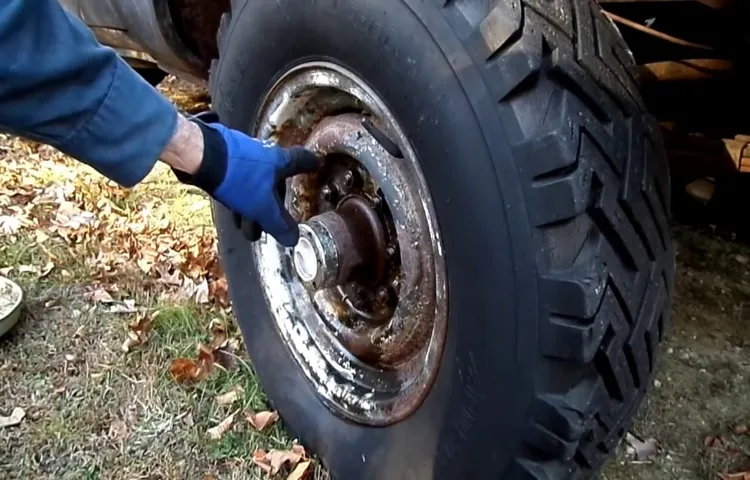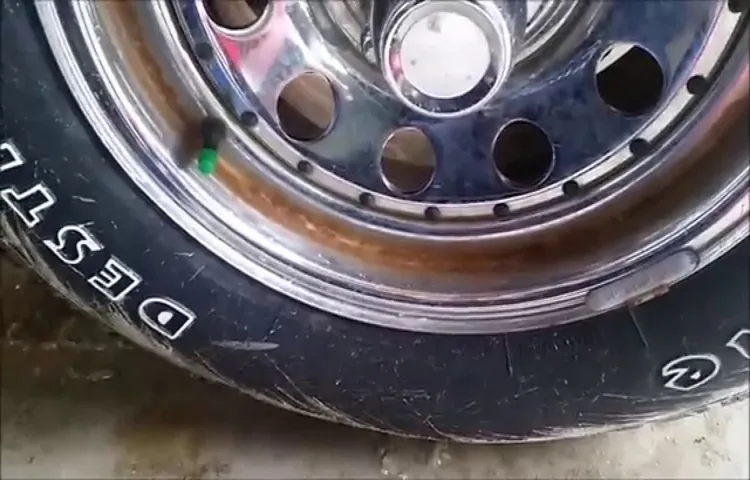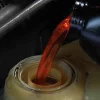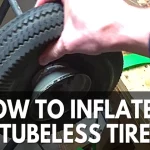Is your tire rim looking a little worse for wear? Are you struggling to remove rust and grime from your wheel? Well, fear not, because we’ve got you covered! In this blog, we’ll be discussing the best tips and tricks for removing a rusty tire rim, whether you’re a seasoned pro or a DIY novice. Firstly, let’s talk about the dangers of leaving rust on your tire rims. Not only does it look unsightly, but it can also weaken the metal and cause irreparable damage in the long run.
That’s why it’s crucial to remove any traces of rust as soon as possible. So, where to start? One option is to use a commercial rust remover, which can be found at most hardware stores. These solutions are designed to dissolve rust on contact, making it easy to wipe away with a cloth or sponge.
However, be sure to follow the instructions carefully and wear protective gloves, as the chemicals can be harmful. Alternatively, you can try making your own rust remover using ingredients such as baking soda and vinegar. Simply mix together, apply to the affected area, and leave to soak for a few hours before scrubbing away with a brush.
Of course, prevention is always better than cure, so it’s important to take steps to prevent rust from forming in the first place. Regular cleaning and maintenance can go a long way in keeping your tires looking pristine, as can investing in quality wheel covers or protective coatings. In conclusion, removing a rusty tire rim may seem like a daunting task, but with the right tools and techniques, it’s a job that can be easily tackled at home.
So, whether you’re a car enthusiast or simply want to keep your wheels in top condition, follow these tips and watch as your tires shine like new!
Table of Contents
Assess the Situation
Removing a rusted-on tire rim can be a challenging task, but with the right approach, it can be done with ease. The first step is to assess the situation. You should take a good look at the rusted-on tire rim and determine the extent of the rust.
Check if the tire is still inflated and if there are any unusual bulges or cracks. If the tire is still inflated, deflate it before proceeding. Then, loosen the lug nuts, but do not remove them completely yet.
Spray a penetrating oil like WD-40 on the lug nuts and around the rim. This will help break down the rust and make it easier to remove the rim. Let the oil penetrate for at least 10 minutes before attempting to remove the lug nuts.
If the lug nuts are still stubborn, use a breaker bar or an impact wrench to help remove them. Once the lug nuts have been removed, carefully slide the tire and rim off the axle. And there you have it, you have successfully removed a rusted-on tire rim.
Remember to clean the rim before putting it back on to prevent future rusting.
Check for Lug Nuts
When it comes to checking for lug nuts, it is essential to assess the situation carefully. You need to understand whether the bolts are fastened correctly or if there is any indication of looseness. If there is a lack of torque, the lug nuts might come off, leading to a potential accident or damage to the tires.
A loose lug nut can cause the wheel to wobble and eventually detach, making it even more dangerous for the driver and other passengers. You can usually check for lug nut tightness by feeling resistance when tightening them by hand or using a torque wrench. If you notice any signs of wear or damage, it’s best to replace them immediately.
Remember, neglecting to check the lug nuts can lead to disastrous consequences, so it’s essential to take this task seriously and ensure the safety of yourself and your passengers.

Check for corroded or seized bolts/nuts
As a responsible car owner, it’s essential to periodically check for corroded or seized bolts/nuts in your vehicle. But before addressing the issue, it’s crucial to assess the situation carefully. Look for any signs of rust or wear and tear on the bolts/nuts.
If the corrosion is only superficial, you may be able to remove it with a cleaning solution. However, if the rust and corrosion are extensive, you may need to replace the bolts/nuts entirely. Moreover, if the nut is seized, applying a penetrating oil like WD-40 may loosen it.
But if it refuses to budge, you might have to employ a wrench or socket to manually turn it. However, it’s vital to use caution as too much force can cause the bolt/nut to snap, turning what should have been a simple fix into a complex and expensive one. Always remember to replace any bolts/nuts that are beyond salvaging and avoid reusing them.
By regularly assessing the situation, you can keep a close eye on your car’s condition and ensure that it runs smoothly and safely.
Gather Materials
If you’re wondering how to remove a rusted on tire rim, the first step is to gather all the necessary materials. You’ll need a lug wrench, penetrating oil, a hammer, a socket wrench set, a rubber mallet, and a pry bar. First, loosen the lug nuts with a lug wrench.
Then, use penetrating oil to loosen the rust and corrosion around the rim. Let it sit for a few moments and then tap the rim gently with a hammer. Next, remove the lug nuts completely with a socket wrench set.
Use a rubber mallet to hit the rim from the backside to loosen it from the hub. If it still won’t budge, use a pry bar to gently separate the rim from the hub. Remember to wear gloves and eye protection throughout the process.
With these tools and some elbow grease, you’ll be on your way to removing that stubborn, rusted-on tire rim.
WD-40, Pliers and a Hammer,
If you’re planning to do some DIY home repairs, you need the right tools. Among the most essential are WD-40, pliers, and a hammer. WD-40 is a versatile product that can lubricate, protect from rust, and even clean sticky residue.
Pliers come in different shapes and sizes and can be used for gripping, twisting, cutting and holding objects. A hammer, on the other hand, is used for pounding nails and shaping wood. When it comes to choosing the right hammer, you need to consider the material you’ll be pounding on and the size of the nail you’ll be using.
While these tools seem basic, they can be incredibly useful for completing a wide range of repairs and improvements around the house. Whether you’re fixing a squeaky door or repairing a leaky pipe, having WD-40, pliers, and a hammer in your toolbox can make the job easier and more efficient. So gather your materials and let’s get to work!
Pressurized air / brazing torch / rust penetrant
When it comes to fixing rusted metal objects, having the right tools and materials can make all the difference. We recommend gathering a few key items, including a pressurized air canister, a brazing torch, and rust penetrant. The pressurized air canister is great for blowing away any loose debris or rust particles, allowing you to see the full extent of the damage.
Next, use the brazing torch to heat the metal, which can help loosen any stubborn rust and make it easier to remove. Finally, apply rust penetrant to the affected area, which will help break down any remaining rust and prevent future rusting. With these materials on hand, you’ll be well-equipped to tackle even the toughest rusted metal repairs.
Spray Rust Penetrant
If you’re struggling to remove a rusted on tire rim, there’s a simple solution: spray rust penetrant. This powerful product softens the rust, making it easier to break apart and remove the rim. To use, simply spray the penetrant onto the rusted areas and let it sit for several minutes.
Then, give the rim a few taps with a hammer to break apart the rust. The rust penetrant should make the process much smoother and quicker, saving you time and frustration. Just be sure to wear gloves and protective eyewear when using the product, as it can be irritating to the skin and eyes.
With a bit of patience and the right tools, you can remove even the most stubborn rusted-on tire rim with ease.
Apply Rust Penetrant to Lug Nuts/Bolts
If you’re encountering stubborn rust on your lug nuts or bolts, it’s time to bring out the big guns and apply a rust penetrant spray. This powerful solution is designed to loosen rust and corrosion, making it easier to remove these stubborn fasteners without causing damage to your vehicle’s bolts or your tools. When using a rust penetrant, it’s important to start by cleaning the affected area with a wire brush or sandpaper, removing any loose dirt or debris.
Next, you’ll want to generously spray the rust penetrant onto the rusted lug nuts or bolts, allowing it to soak in for several minutes. Once the penetrant has had a chance to work its magic, you can use a wrench to try to loosen the fastener. If it doesn’t easily come off, repeat the process until it finally budges.
With a good rust penetrant and a bit of elbow grease, you’ll be able to remove even the rustiest of fasteners.
Wait 10-15 minutes to let it soak in.
If you’re working on a rusty project and need to loosen those stubborn bolts, a Rust Penetrant is a must-have in your tool kit. This powerful spray helps to dissolve rust and corrosion, making it much easier to remove metal parts that have seized up over time. Simply spray a liberal amount onto the affected area and let it sit for at least 10-15 minutes to allow the solution to penetrate the metal.
The longer you wait, the better. This gives the spray enough time to get deep into the rusted area, breaking down the buildup of corrosion. After this time has passed, you should be able to use a wrench or socket to remove the affected part without too much difficulty.
It’s important to note that different brands of Rust Penetrant have varying dwell times for best results, so be sure to read the instructions carefully. Also, make sure to shake the can thoroughly before use to ensure even coverage. Rust Penetrant is highly effective for loosening rusted bolts and parts, but it’s worth keeping in mind that it’s not a permanent solution.
To prevent rust buildup from occurring in the first place, it’s recommended to use a rust inhibitor after you’ve completed your project. If you don’t have any rust inhibitor, a simple solution of half vinegar and half water can also help to prevent rust buildup on metal surfaces. So the next time you’re working on a project with rusted parts, be sure to have a Rust Penetrant on hand to make your job easier and faster.
Break the Corrodedness
If you’ve ever come across a tire rim that’s rusted on, you know just how frustrating it can be. Not only does it look unsightly, but it can also make removing the tire a real challenge. Thankfully, there are steps you can take to break the corrodedness and get that tire off.
The first step is to remove as much rust as possible with a wire brush or sandpaper. Then, apply a rust penetrant to the affected area and let it sit for a few hours. Once the penetrant has had time to work its magic, you can try using a rubber mallet to gently tap the rim from different angles.
If that doesn’t work, using heat from a blowtorch can help loosen the rust. Be sure to aim the heat at the center of the rim and avoid holding the torch in one spot for too long. With some patience and persistence, you should be able to break the corrodedness and remove that rusted on tire rim.
Tap Around the Rim With the Hammer.
If you’re dealing with a rusty or corroded surface, tapping around the rim with the hammer might just be the trick to break the corrodedness. Sometimes it’s not enough to simply scrape away the rust – you have to approach it from a different angle. By tapping the metal gently with a hammer, you can actually loosen up some of the corrosion and make it easier to remove.
Of course, you don’t want to go overboard and damage the metal, so it’s important to use a light touch and be patient. This technique is especially useful for older or neglected machinery, where the rust has had time to really set in. Give it a try and see if it works for you – you might be surprised at how effective it can be.
Use a Rubber Mallet to Loosen the Rim.
One of the biggest challenges when working on a bike is dealing with rusty or corroded rims. It can be frustrating trying to loosen these rims, but one solution is to use a rubber mallet. This tool can help break the corrosion and loosen the rim while minimizing the risk of causing any damage.
First, try spraying some WD-40 or a similar lubricant onto the corroded area and let it soak in for a few minutes. Then, use the rubber mallet to gently hit the rim, working your way around the wheel to ensure that all areas are loosened. The rubber mallet helps to absorb the shock of each hit, reducing the chances of cracking or breaking the rim.
This method may require a bit of patience and persistence, but it can be a great way to loosen corroded bike rims and get your wheels spinning again!
Remove the Rim
Removing a rusted on tire rim can be a daunting task, but it is doable with some elbow grease and the right tools. To start, you will need to safely jack up the vehicle and remove the lug nuts. If the rim is still stuck, you can try using a rubber mallet to tap around the edge of the rim to loosen any rust or debris.
If that doesn’t work, you can use a rust penetrant spray and let it sit for a few hours to break down any rust. Next, you will want to use a pry bar or tire iron to carefully pry the rim away from the hub. Be sure to work slowly and gently, as excessive force can cause damage to the wheel or suspension.
With a little patience and persistence, you can remove that stubborn rusted on tire rim and get back on the road in no time!
Use Lubricant if Necessary,
When it comes to removing the rim from your car tire, there are certain steps you need to follow to ensure a safe and successful process. One of the most important factors to consider during this procedure is lubrication. If you’re having difficulty removing the rim, adding some lubricant to the equation can make a world of difference.
It will make the process smoother and easier, reducing the likelihood of damaging your tire or rim. It’s important to note, however, that not all lubricants are created equal. Be sure to choose one that’s safe for use on tires and won’t corrode the rim or damage the rubber.
With the right lubricant and a bit of patience, removing the rim should be a breeze. Remember, taking your time and working carefully will yield the best results. So, if you’re struggling to remove the rim on your car tire, consider adding lubricant into the mix to ease the process.
Remove the nuts one by one with the Pliers,
To remove the rim from your car, you’ll need to first remove the nuts holding it in place. This can easily be done one by one with a pair of pliers. But before getting started, make sure your car is on a flat and level surface.
Using the pliers, turn the nuts anticlockwise until they come off completely. Be careful not to let the wheel fall off while doing this. Once all the nuts are off, you can then carefully lift the wheel away from the car.
If you’re having trouble loosening the nuts, try spraying some penetrating oil on them first. With a little patience and care, removing your car rim can be a quick and easy process. Before you know it, you’ll be ready to install your new rims and hit the road!
Lever the rim out from the wheel harmoniously,
Removing the rim from a wheel can be a daunting task, but with the right technique, it can be done easily without damaging the wheel or the rim itself. Firstly, locate the valve stem on the rim and deflate the tire by removing the valve core. Next, use a tire leaver to pry the tire away from the rim, starting at the valve stem and working your way around the circumference of the wheel.
It’s important to leverage the rim out from the wheel harmoniously to prevent any damage to the wheel. Be careful not to put too much pressure on the leaver and avoid forcing it if it doesn’t seem to budge. Once the tire is separated from the rim, gently lift the rim off the wheel.
Remember to take your time and be patient when removing the rim to ensure a successful process. In conclusion, removing a rim from a wheel can seem like a daunting task, but it’s manageable with the appropriate technique. Deflating the tire, using a tire leaver, and leveraging the rim out from the wheel harmoniously are the keys to success.
It’s essential to exercise patience and avoid applying too much force to prevent damage to the wheel or rim. With care and attention, you’ll be able to remove the rim efficiently and effectively.
Clean and Repair
Removing a rusted-on tire rim can be a challenging task, but with the right tools and techniques, it can be done easily. First, start by cleaning the rim thoroughly. You can use a degreaser to remove any dirt, grime or oil from the surface.
Next, spray a penetrating lubricant around the lug stud holes and wait for a few minutes. This will help to loosen the rust and make it easier to remove the rim. Now, use a rubber mallet or a hammer to strike the rim gently around the edges.
This will help to break the rust and loosen the rim from the hub. Finally, use a lug wrench to remove the lug nuts and carefully take off the rim. If the rim is still stuck, you can use a pry bar to wedge between the rim and the hub and pry it off gently.
Always remember to wear protective gloves and eyewear when dealing with rust and sharp metal objects. With these tips, you can now remove a rusted-on tire rim with ease.
Clean the Wheel Area Completely.
When it comes to keeping your car in top condition, cleaning and repairing the wheel area is an essential step. Over time, dirt, dust, and debris can accumulate in the wheel well, which can lead to corrosion and damage to the wheels and brakes. To clean this area, start by removing any loose debris with a vacuum or a brush.
Next, use a spray-on wheel cleaner and a microfiber towel to wipe away any remaining dirt and grime. Be sure to get into all the nooks and crannies, including behind the brake calipers. If you notice any damage or rust, take the time to make any necessary repairs.
This might involve replacing parts or sanding down any rough or corroded areas. With a little bit of effort and attention to detail, you can keep your wheels and brakes looking and performing like new. So, the next time you’re washing your car, don’t forget to focus on the wheel area!
Repair Dents and Scratches in the Rim.
When it comes to repairing dents and scratches in your car’s rim, the first step is to clean the affected area. Start by removing any dirt, grime, or brake dust buildup that might be covering the scratch or dent. You can use a soft cloth and a mild detergent solution to gently scrub the area, being careful not to damage the rim’s finish.
Once the area is clean and dry, assess the damage. If the scratch is minor, you can use a touch-up paint to cover it up. However, if the scratch is too deep, you might need to sand and repaint the rim.
For dents, gentle pressure and a plunger can sometimes pop them out. If the dent is large, it might require professional repair services. Remember to always take safety precautions when handling the rim.
With a little bit of elbow grease, you can repair the dents and scratches in your rim and restore its appearance.
Conclusion
In conclusion, removing a rusted on tire rim can be a frustrating and challenging task. But fear not, with the right tools, patience, and a touch of ingenuity, even the most stubborn rims can be loosened. Think of it as a puzzle to be solved, a battle to be won, or a metaphor for overcoming adversity in life.
So go forth, my fellow DIY enthusiasts, and conquer those rusty rims with a wit and clever resolve that would make MacGyver proud.”
FAQs
What causes tire rims to become rusted?
Tire rims can become rusted due to prolonged exposure to moisture and salt on roads during winter months.
Can I still use a rusted on tire rim?
It is not recommended to use a rusted on tire rim as it can compromise the safety of the vehicle.
How do I remove a rusted on tire rim?
First, spray the rusted area with a penetrating oil and let it sit for a few hours. Then, use a hammer and a block of wood to gently tap the rim around the edges. Finally, use a lug wrench to loosen the bolts and remove the seized rim.
Can I prevent tire rims from becoming rusted?
Yes, you can prevent tire rims from becoming rusted by keeping them clean, using a rust inhibitor, and storing them in a dry place.
What should I do if I cannot remove a rusted on tire rim?
If you cannot remove a rusted on tire rim, it is best to take your vehicle to a professional mechanic for assistance.
How do I maintain my tire rims to prevent rusting?
To maintain your tire rims, you should clean them regularly with a gentle cleanser and a soft brush. Additionally, you can apply a protective coating of wax or sealant to prevent rust from forming.
Can a rusted tire rim be repaired?
In some cases, a rusted tire rim can be repaired by sanding and filling the rusted areas with a filler product. However, it is recommended to replace severely rusted rims for safety reasons.



